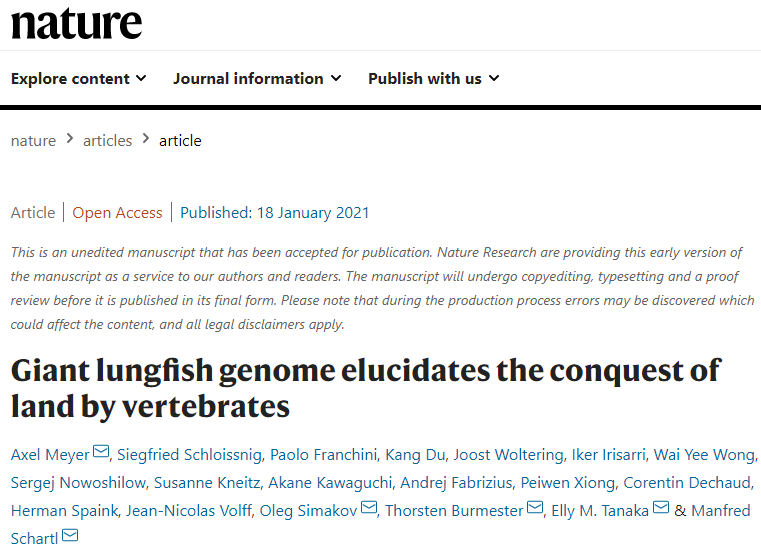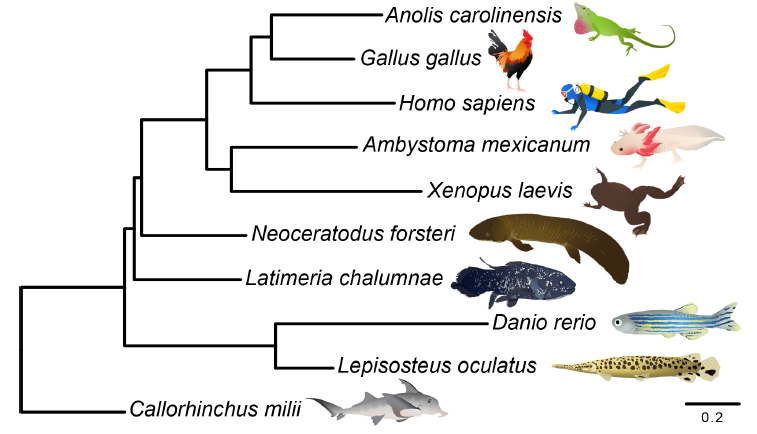Nature: The evolution mechanism from fish to human
- Normal Liver Cells Found to Promote Cancer Metastasis to the Liver
- Nearly 80% Complete Remission: Breakthrough in ADC Anti-Tumor Treatment
- Vaccination Against Common Diseases May Prevent Dementia!
- New Alzheimer’s Disease (AD) Diagnosis and Staging Criteria
- Breakthrough in Alzheimer’s Disease: New Nasal Spray Halts Cognitive Decline by Targeting Toxic Protein
- Can the Tap Water at the Paris Olympics be Drunk Directly?
Nature: The evolution mechanism from fish to human
- Should China be held legally responsible for the US’s $18 trillion COVID losses?
- CT Radiation Exposure Linked to Blood Cancer in Children and Adolescents
- Can people with high blood pressure eat peanuts?
- What is the difference between dopamine and dobutamine?
- What is the difference between Atorvastatin and Rosuvastatin?
- How long can the patient live after heart stent surgery?
Nature: The evolution mechanism from fish to human. Nature | Great Discovery!
The genome of the human relative of lungfish is resolved: the evolution mechanism from fish to human is revealed for the first time.
Systems biology analysis has determined that lungfish, as the closest relatives of tetrapods, are in a key position in evolution, which highlights their importance for understanding the innovations related to terrestrialization.
Lungfish is a leaf-finned fish (Sarcopterygii), which adapted to the terrestrial climate during the Devonian period, leading to the production of all terrestrial vertebrates, including humans.
For the evolution and adaptation that accompanies the transition of vertebrate life from water to land, lungfish is essential.
This major evolutionary event requires a series of evolutionary innovations, including breathing, limbs, posture, preventing dryness, nitrogen excretion, reproduction, and smell.
The lungfish is known to have the largest animal genome, but the mechanism that causes and maintains its genome size is still poorly understood.
On January 18, 2021, Axel Meyer et al. published a research paper entitled “Giant lungfish genome elucidates the conquest of land by vertebrates” in Nature.
The study determined the animal genome with the largest chromosome quality, Australian lungfish, new Dogfish.
Its huge size (approximately 14 times that of the human genome) is mainly attributed to the huge intergenic regions and high repetitive content (approximately 90%) of introns, and its composition is more like quadrupeds than ray fin fish (mainly Is the LINE element).
Compared with the huge genome, the lungfish genome continues to expand independently and through different mechanisms (its TEs are still active).
Systems biology analysis has determined that lungfish, as the closest relatives of tetrapods, are in a key position in evolution, which highlights their importance for understanding the innovations related to terrestrialization.
Ways to adapt to terrestrial life include obtaining limb-like expression of developmental genes like hoxc13 and sall1 in its lobes.
The evolution and repetition rate of genes related to respiration (such as lung surfactants) has increased, and the expansion of the gene family of odorant receptors for detecting odors in the air has also helped them to develop quadruped-like biology.
These findings advance our understanding of this major shift in vertebrate evolution.

Dipnoi and vertebrates living on land have the ability to breathe air through our lungs.
Since its discovery in the 19th century, lungfish has attracted scientific interest and was originally thought to be an amphibian.
We now know that they are more closely related to quadrupeds than to ray fish. Of the only six living lungfish species, four live in Africa, one in South America and one in Australia.
In the Devonian period about 400 million years ago, lungfish appeared in the fossil record. Some people think that lungfish are “living fossils” because their shape has hardly changed.
Due to its ancient characteristics, such as body shape, large scale and paddle fins, Australian lungfish (Ambystoma mexicanum) is the most typical lungfish in existence.
The South American and African lung lungfish then lost their scales and simplified the fins to thin filaments, despite exhibiting an alternating gait typical of land transport.
 Phylogenetic diagram (picture from Nature)
Phylogenetic diagram (picture from Nature)
Together with the coelacanth and the tetrapod lungfish are members of Sarcopterygii (leaf-fin “fish”), but because the branches separating these three ancient lineages are short, it is still difficult to resolve the relationship between them.
The development of powerful DNA sequencing and computational methods now allows the use of whole-genome data sets with stronger orthogonal inference to solve this long-standing evolutionary problem.
Recent analyses using large transcriptome data tend to support the hypothesis that lungfish are the closest relatives of tetrapods.
Therefore, lungfish are essential for the evolution and adaptation that accompany the transition of vertebrate life from water to land.
This major evolutionary event requires a series of evolutionary innovations, including breathing, limbs, posture, preventing dryness, nitrogen excretion, reproduction, and smell.
The lungfish is known to have the largest animal genome, but the mechanism that causes and maintains its genome size is still poorly understood.
Therefore, Australian lungfish may provide insights into the evolution of tetrapods and the evolution and structure of giant genomes.
The study identified the animal genome with the largest chromosomal quality, the Australian lungfish, the new dogfish.
Its huge size (approximately 14 times that of the human genome) is mainly attributed to the huge intergenic regions and high repetitive content (approximately 90%) of introns, and its composition is more like quadrupeds than ray fin fish (mainly Is the LINE element).
Compared with the huge genome, the lungfish genome continues to expand independently and through different mechanisms (its TEs are still active).
Systems biology analysis has determined that lungfish, as the closest relatives of tetrapods, are in a key position in evolution, which highlights their importance for understanding the innovations related to terrestrialization.
Ways to adapt to terrestrial life include obtaining limb-like expression of developmental genes like hoxc13 and sall1 in its lobes.
The evolution and repetition rate of genes related to respiration (such as lung surfactants) has increased, and the expansion of the gene family of odorant receptors for detecting odors in the air has also helped them to develop quadruped-like biology.
These findings advance our understanding of this major shift in vertebrate evolution.
Nature: The evolution mechanism from fish to human
(source:internet, reference only)
Disclaimer of medicaltrend.org



